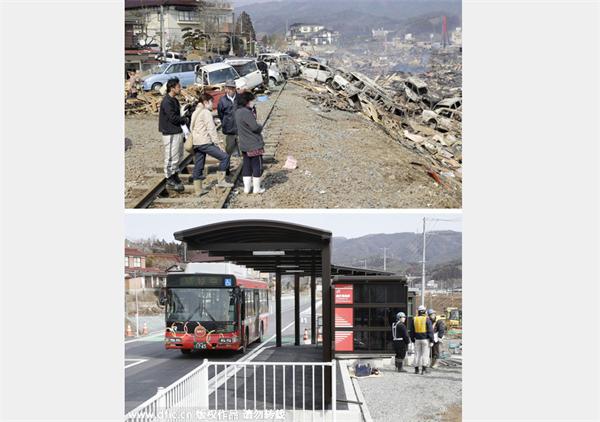 |
|
The tsunami-devastated train station in Kesennuma town in Miyagi prefecture is seen in these images taken on March 13, 2011 (top) and March 3, 2015 (bottom), ahead of the four-year anniversary of the March 11, 2011 earthquake and tsunami disaster. The bottom photograph shows the same location, now on the bus rapid transit (BRT ) route. [Photo/IC] |
I knew it was a big earthquake when the bathtub I was in started juddering. Fortunately, I thought, a bathroom is supposed to be the safest place to be in an apartment when a quake strikes.
Turning on the TV, I learnt there had been a magnitude-8.5 earthquake - adjusted to 7.8 the next day - off the coast of Japan. The whole nation trembled. But luckily the epicenter was 676 kilometers deep and did not result in a large tsunami. Twelve people suffered minor injuries, and no buildings collapsed.
The May 30 quake was the second sizable temblor Tokyo felt in a week. A much weaker - but far shallower - earthquake occurred close to the capital on May 25.
The latest big quake caused nearly 20,000 elevators in Tokyo's high-rise buildings to cut out. More than 400 people were trapped in the observation section of a 54-story building for more than an hour.
These incidents have driven Japan's infrastructure ministry and elevator manufacturers to agree on installing toilets in elevators.
Japan's government estimates that the next "BigOne"-a huge quake Japanese seismologists say is almost certain to hit Tokyo over the coming decades-may leave up to 17,000 people stranded in elevators.
Hit by one-fifth of the world's most powerful earthquakes, Japan is constantly ready for the "BigOne".
Japan's latest simulations warn that a magnitude-9 earthquake in the Nankai Trough, an area off the Pacific coast of central and western Japan, could cause 320,000 fatalities in the worst-case scenario. A magnitude-7 quake directly hitting the Tokyo metropolitan area could result in 23,000 deaths, with the number possibly up to 70,000 in a magnitude-8 quake.
For decades, the country has made its people prepared for such a disaster. Sept 1, which marks the anniversary of a massive 7.9-magnitude earthquake that struck Tokyo in 1923, killing more than 100,000 people, has been designated as Disaster Prevention Day since 1960.Drills are done nationwide that day. Now when the earth begins to shake, every school-child knows what to do: They slip a padded cover on their heads and duck beneath the nearest desk; those who are at home know, almost instinctively, to open the front door in case it is necessary to make a quick exit to open ground.
All-in-one emergency survival backpacks are easily found in department stores. Neighbor-hoods are organized with water storage facilities. Parks, shrines and temples are designated as congregation points in case of disaster.
Japan also has some of the world's most rigorous building codes, focusing on earthquake preparedness.
And it boasts the world's most sophisticated earthquake early-warning systems. Television broadcasts are immediately replaced by live coverage in the event of a sizable quake. And Japan's three phone carriers-NTT Docomo, Softbank, and AU-started issuing earthquake warnings in 2007. Scarier than the earthquakes themselves are the phone alarms going off right before and during a quake. The sound - rather than the shaking - usually freaks me out.
Japan is a country that is lauded for doing preparedness right. But the earthquake and tsunami on March 11, 2011 showed the limits of what even the best preparations can do. The magnitude-9 Tohoku earthquake, which struck about 230 miles northeast of Tokyo, produced a 23-foot tsunami that left 15,839 dead, 5,950 injured, and 3,642 missing, according to the official toll.
The Tokyo Metropolitan Government has urged businesses to keep enough emergency food and water on-site for employees to last three days.
The country's Central Disaster Prevention Council recommends that homes store one week's worth of supplies like water and dry food.
In a country where minor earthquakes occur daily, some people, I was one of them, do not recognize the importance of the recommendations.
But now I'm off to get myself an emergency survival kit.
The author is China Daily's Tokyo bureau chief. caihong@chinadaily.com.cn

I’ve lived in China for quite a considerable time including my graduate school years, travelled and worked in a few cities and still choose my destination taking into consideration the density of smog or PM2.5 particulate matter in the region.